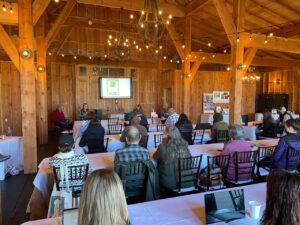Final report for WSP20-004
Project Information
Montana will use 2021 WSARE PDP grant funding to continue our professional development mini-grant program. These mini-grants, usually $2,500 or less are offered to Cooperative Extension professionals, university researchers and staff, non-profit agricultural advocacy organizations, agricultural producers and producer associations, and other entities and organizations involved in sustainable agricultural practices. In 2021 we expect to fund 8 to 10 mini-grant opportunities for professional development.
Of the grants funds distributed to Montana through the state implementation grant, we plan to utilize approximately $24,000, or 83% of funds to directly fund professional development opportunities to the mini-grant recipients. These mini-grant funds will be used as support funds to organize and hold professional development conferences and trainings for crops and livestock systems, host educational farm field days to present sustainable practices on the farm, host in-depth trainings to provide new information and additional knowledge and skills to producers, educators, and consultants, provide travel scholarships to conferences, and create opportunities for producers and communities to engage in economic growth and development possibilities to support agricultural enterprises.
Montana’s short term objective through the PDP mini-grant program is to increase the knowledge, skills, and understanding of sustainable agricultural agriculture professionals and producers, with the ultimate objective of documented implementation of that new knowledge at the producer and agribusiness level. With the mini-grant system, the Montana PDP program supports multiple projects in different fields of agriculture, and increases the overall impact of funding through offering a wide variety of project types. In 2020, seed potato producers, beef cattle ranchers, berry growers, certified organic growers, cereal grain producers, and many other groups of constituents all applied to receive funding for professional development programming. The diversity of opportunity to gain new knowledge and information directly related to the specialty field the agricultural producers and professionals work in helps to inform and encourage a change in practice when presented with new and innovative approaches to agriculture and sustainability.
Advisors
- - Technical Advisor
- - Technical Advisor (Educator)
- - Technical Advisor
- - Technical Advisor (Educator)
Education
The Montana WSARE Professional Development Grant Program strives to offer professional development opportunities to agricultural professionals across the state, including Extension agents, agency representatives, non-profit agricultural advocacy groups, university research scientists, and farmers and ranchers. These professional development opportunities are made possible through a competitive mini-grant program for travel, or the development of a professional development opportunity. Successful mini-grant recipients use grant dollars to fund travel to professional conferences and seminars to learn information that will benefit their constituents. These travel mini-grants allow for a quick spread and dissemination of information from the professional who was awarded the grant through to local area producers and stakeholders through the programming and efforts they design and implement back in their home communities. Other mini-grant recipients organize and deliver field days, local workshops, or other professional development events to producers and other agricultural professionals in their area with the grant funds, to offer information and learning opportunities locally
Education & Outreach Initiatives
The main goal of the project is to provide two workshops for Extension Agents on the forage nitrate strip test. The first workshop will focus providing needed kits and knowledge to the Extension Agents frequently conducting nitrate testing for their clientele. By providing needed Nitrate Strip Test training and kits to Extension Agents, we support the goals of Western SARE through sustaining economic viability of agricultural operations and enhancing environmental quality and the natural resource base upon which the agricultural economy depends.
Stakeholders rely on Extension Agents to aid in harvesting and feeding decisions when there is a potential for nitrates. The two workshops will teach valuable skills to field agents to better support their constituents.
At the first workshop, at Ag Agent Update, in May 2021, 16 Nitrate Strip Test kits were provided to Extension Agents that requested one. Training was also provided at the workshop on how to use the kit and interpret results. Since providing the kits with the MT SARE funding, several other agents have reached out for kits and/or a kit supply list. In discussing the need of the kits with Mike Schuldt, Custer County Ag Extension Agent, we may discuss offering the kit though the MSU Extension Store for producers and Agents to purchase.
The second workshop occurred in May of 2022 at the Agriculture and Natural Resources Program Update in , where collected statewide data was reviewed . A Share Point site for Extension Agents to upload their Nitrate Strip Test results was created to facilitate continued data collection. Dr. Hayes Goosey and I discussed developing this site so that we may be able to create a Nitrate database for the state of Montana with different forages and conditions over a number of years.
Stakeholders rely on Extension Agents to aid in harvesting and feeding decisions when there is a potential for nitrates. The second workshop was to take place during the Annual Extension Conference in October 2021; however, due to COVID, that conference was cancelled and postponed until Spring 2022. The main goal of the second workshop was to gather data regarding the use of the Nitrate Strip Test and to evaluate the forage samples tested.
These kits provided an additional opportunity for Extension Agents to visit with their clientele and stakeholders about the importance of nitrate testing and being able to provide a quantitative rapid measurement prior to harvest. Additionally, this may have led to a reduction in the cost to the producer to send samples to a commercial lab for analysis. This also limited the amount of time a producer needed to wait to harvest compared to previous use of the Nitrate QuikTest, which only provided a “yes or no” answer on if nitrates were present. Due to the ongoing drought in Montana, many Extension Agents were able to have in-depth conversations about nitrates and the risks with feeding forages with more risky levels of nitrates.
The Extension Agents using the Nitrate Strip Test are able to provide a quantitative measurement to their clientele and stakeholders. This allows those clientele to make informed decisions for harvest and feeding. This also allows for producers to make better management decisions on future purchases or selling of tested forages.
The North American Invasive Species Management Association (NAISMA) held its annual conference September 27 through October 1. The conference was scheduled to occur in Missoula, MT, providing an excellent opportunity for Extension professionals interested in invasive species to attend with less effort than would be typical for this conference, which can occur anywhere in the U.S. or Canada. Due to the COVID19 pandemic, the conference was held virtually. Funds from the WSARE Professional Development Program (PDP) covered registration for six Extension professionals to attend the virtual conference. Two additional faculty chose not to attend once the conference switched to a virtual platform.
The North American Invasive Species Management Association (NAISMA) annual conference
included an opening general session with keynote speaker each day followed by breakout sessions by topic area. Topic areas included:
- transboundary cooperation
- aquatic invasive species
- biological control
- diversity/equity/inclusion aspects of invasive species naming
- annual grass control
- weed free products
- invasive species policy
- economics of invasive species
- pest detection and management
- pesticide CEU processes
- citizen science
- eDNA
- early detection and rapid response (EDRR)
- climate change and invasive species
- identifying noxious weeds and their native look a-likes
Extension faculty who attended had their choice to attend breakout sessions of most interest to them. To create common ground among Extension faculty who attended, we collectively joined one session each day. These sessions included the Weed Free Products panel on day 1, Invasive Species Policy on day 2, and Outreach Tools for Awareness and Prevention on day 3.
A follow-up discussion “Weed Management with an Eye to the Future” was held at the Extension annual conference on October 12. This allowed those who attended NAISMA to discuss key concepts from the common sessions we attended as well as to welcome into the discussion other Extension professionals who did not attend NAISMA. Noelle Orloff, Dr. Tim Seipel, and I hosted this session. About 30 Extension professionals attended to discuss drought and climate change, weed-free products, and other timely information related to weed management. We identified at least one action item to accomplish in the next 12 months, that being to organize a weed seed-free products training for Extension professionals with Montana Department of Agriculture; an emphasis on the new weed seed-free gravel program is of particular interest.
In a post-conference survey of Extension professionals who attended NAISMA and the Extension annual conference discussion, all respondents (4) said they will probably implement something in their local programming that they learned through this project. Topics identified as most useful included tools that enhance biological control, invasive annual grass management, invasive species policy, Working Dogs for Conservation, weed free products, and diversity/equity/inclusion regarding invasive species common names.
The post-conference survey showed a 12.5-point improvement in Extension professionals’ level of knowledge about invasive species because of attending the NAISMA conference. On a scale of 1 (low) to 100 (high), respondents average self-rated knowledge about invasive species was 76 prior to attending the conference; after attending the conference the average self-rating was 84.5.
As mentioned above, every Extension professional who participated in the NAISMA conference indicated “probably yes” when asked if they would implement anything from the conference in their local programming. Results were more mixed in response to the session at Extension annual conference: responses ranged from “might or might not” to “probably yes” to “definitely yes.” No one responded “probably not” or “definitely not,” which indicates an overall positive impact for those Extension professionals who chose to participate in this project.
Through this grant opportunity Community Food and Agriculture Coalition (CFAC) was able to organize and host 5 Farmer Field Days during the summer and fall of 2021. Topics and sites were selected based on feedback from beginning and established farmers.
Farmer Field Days have been an integral part of the Community Food & Agriculture Coalition’s (CFAC) workshops series offered to beginning farmers in western Montana for six years. Each field day usually last 2 hours. During the field day participants get to learn about a specific topic by an experienced farmer. Participants get to see first-hand the techniques and processes the farmer uses. Most field days also include a hands-on portion, where participants get to try out techniques and methods. Additionally, Farmer Field Days are a great way for farmers to teach farmers new skills. Through this grant CFAC has continued to build teaching and training capacity directly in the farming community.
In 2021 five field days were hosted around western Montana:
Cold-Hardy Berry Production – July 21st – Hilltop Haven Farm
High-Density Rotational Grazing – August 12th – Shady Maple Farm
Low Till Techniques for Vegetable Farmers – September 1st – SweetRoot Farm
Orchard and Vineyard Management – September 15th – Western Ag Research Center
Seed Saving Techniques for Small Scale Producers – October 13th – Homestead Organics
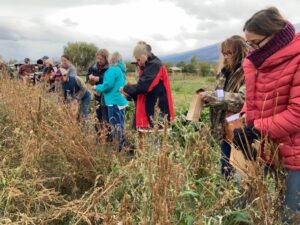
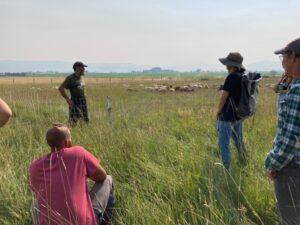 79 participants attended the 5 Farmer Field Days over the course of the summer and fall of 2021, and 8 established farmers acted as instructors at the field days.
79 participants attended the 5 Farmer Field Days over the course of the summer and fall of 2021, and 8 established farmers acted as instructors at the field days.
34 participants filled out evaluations at the end of the field days (43%). CFAC strives for full participation in field day evaluations, but due to participants leaving early, partially filled out evaluations, or lack of interest, participation in evaluations was lower than usual this summer. CFAC provides both online and paper evaluations options to help combat this issue.
Of the 33 participants that filled out a survey 30 participants (90%) identified an increase in knowledge in the field day topic after the event.
90% of participants identified a learning goal and reported achieving that learning goal. Below are some examples of learning goals:
“Small scale multi-species grazing”
“I [am] hoping to gain some knowledge on shoulder season/winter grazing techniques for multi-species operations”
“Wanted to compare/contrast the berry production on my farm with other operations”
“Knowledge about irrigation and plant varieties”
“Understanding current markets and growing berries in Montana”
“Learn more about seed saving in Montana”
“Hands on seed work”
“Meet people, get a sense of farming in this part of the country, and think about plants and peoples relationships to them”
In spring/summer 2021, WARC staff assisted 23 growers with orchard soil and foliar sampling. The purpose of this sampling was to help individual growers develop a baseline understanding of their orchard nutrition needs and determine what nutrient deficiencies or imbalances were present in Montana orchards across the state.
Orchards were surveyed in the Bitterroot, Missoula, Flathead, Clark’s Fork, Ruby and Gallatin Valleys as well as the Hi-Line. In some cases multiple samples were collected from orchards when potential nutrient deficiencies were noted by growers. A total of 30 foliar samples and 22 soil samples were taken. Spectrum Analytics was used as both the soil and foliar testing lab as they have robust experience with analyzing foliar apple samples and several standards to use for comparison. In cases where orchards had a recent soil sample these were used in place of additional sampling. Orchards also received a soil probe for their personal use which can also be shared with neighboring orchards to promote future sampling and monitoring of orchard nutrition.
Orchard soils were sampled for pH, OM, CEC and primary micro and macronutrients. Average pH was 7.0, however, as expected a majority of orchards had pH’s above 7.2 which is considered high for an orchard. Somewhat surprisingly, orchards surveyed in the Bitterroot Valley had significantly lower soil pH then other regions across the state (P=.002, see Figure 1). On average % soil organic matter was 2.5%, ranging from 1.0-4.1% with 45% of samples in the 2-3% organic matter range (see Figure 2). There was no significant difference in % organic matter based on region. Both pH and % organic matter are typical for Montana soils which tend to have higher pH and low organic matter on account of soil parent materials, soil age and climate.
In terms of available nutrients, most orchard soils were deficient in boron (84%), sulfur (55%) and copper (27%). Additional deficiencies were reported in phosphorus, zinc, iron and manganese. A majority of orchards also had high levels of soil magnesium (50%) and calcium (61%) with some orchards also reporting elevated phosphorus, potassium, zinc and manganese. The high pH, low organic matter and calcareous qualities of Montana soils likely influence the low availability of these micronutrients. Elevated levels of nutrients may be attributed to orchard management including fertilizer or pesticide inputs containing these nutrients, or in some cases parent material and/or irrigation water.
This survey confirmed that many Montana orchards must overcome high pH and low organic matter soils to supply trees with important nutrients. Foliar results confirmed that Zn and B are micro-nutrients Montana growers should supplement and carefully monitor. Additionally, despite elevated levels of Ca, Montana orchards had consistently low levels of foliar Ca. This is a common experience of growers across the West who must manage Ca nutrition by addressing tree vigor, irrigation practices and crop load in addition to providing foliar sprays as high soil Ca does not guarantee plant uptake and further allocation to fruit.
One surprising result of this survey was the number of orchards deficient in foliar Cu (43%). While results indicating low soil Cu are not necessarily surprising, Montana orchards are often treated with copper sprays to prevent fire blight. This is typically enough to supply the needs of the trees as well, however this might not be the case for all orchards given these results.
Pre-project survey results indicated that there was a need among apple growers for more information about orchard nutrition. Only 36.8% of those surveyed reported they had a plan for managing orchard nutrition and while 26% reported they suspected they had issues 41% felt they had no nutrition issues in their orchard. Post survey results indicated that in fact all but 1 orchard had some nutrient deficiency in foliar samples, with most reporting two or more and up to six deficiencies. By addressing these nutrient issues growers may improve yields and the overall health of their trees.
Post-survey results also indicated that this project changed grower management and improved knowledge overall. Nine growers responded to the survey and 100% indicated that the project would change their management decisions. Of those 78% indicated that they felt this would increase their revenue. Additionally, 66.7% said they would continue foliar and soil testing with the remainder indicating that they might, identifying their biggest barriers to employing informed nutrient management to be knowledge of how much to apply, when to apply and the tools to apply fertilizers. To address some of these barriers, WARC, has drafted a nutrition resource for Montana orchards and is actively contributing to Ch. 11 “Nutrition” in the Intermountain Tree Fruit Production Guide to help inform growers of typical nutrient issues in orchards and the best ways for addressing them. While application rates are not provided for all, as these are often circumstantial, the guides do provide a framework for interpreting results and determining rates. As one grower shared in the post-project survey, the first step to overcoming this knowledge barrier is plant nutrient analysis to reveal what is actually needed, “A lot of times I think of NPK, but forget other vital nutrients like Boron, Copper, and Calcium. This was tremendously helpful for putting a plan together for the upcoming season!”
Acquire new knowledge and information about vineyard management through online training modules to better support Montana's grape vineyards as a project specialist.
During the spring semester of 2021, I participated in two courses offered through the Viticulture Enology Science and Technology Alliance (VESTA) program to gain further knowledge and context for my position as Vineyard Program Manager at the Western Agricultural Research Center (WARC). These courses were offered online in conjunction with field practicum sessions, where I had the opportunity to apprentice with Tongue River Winery (Miles City, MT), a commercial vineyard and winery.
Throughout the course of the spring semester, I was able to delve deeper into a wide range of viticulture and winemaking practices — from planning a new vineyard to managing irrigation, fertility, and pests to tweaking all of the various chemistry involved in the winemaking process. One of the most intriguing takeaways from the virtual classroom stemmed from the fact that my classes were taught by professionals with experience primarily within the more traditional grape and wine industry — that is, individuals who have mostly worked with Vitis Vinifera (often referred to as European varieties), rather than the cold-hardy hybrids that we are typically limited to growing in Montana’s harsher climate. I found that, not only did their perspectives help me to better understand the unique positioning of cold-hardy grapes in the wider industry, I believe my own perspective and knowledge was also enlightening to other students in the class, who had no previous knowledge of or experience with cold-hardy grapes. In this way, I hope that I was able to contribute to the wider awareness of cold-hardy grapes in the larger commercial grape and wine industry in the country.
I also benefited immensely from the opportunity to receive hands-on training and mentorship from Bob Thaden, the owner of Tongue River Winery (TRW), as part of the practicum portion of the courses. While on site, I received a detailed overview of TRW’s growing and winemaking processes from start to finish, paying particular attention to practices that might benefit other growers and winemakers who are working with cold-hardy grapes. I was also able to provide some new insights and suggest practices that TRW might use in assessing bud injury and adjusting pruning strategies — topics which I was able to delve deeper into in my VESTA courses. The only unfortunate piece of the practicum visit was that, due to various COVID exposures and precautions, I was not able to visit any other vineyards or wineries while in eastern Montana. I was, however, able to stay in touch via phone and email to provide advice throughout the season, offering advice one everything from dormant pruning to soil fertility to disease management.
I was able to immediately apply all of this newfound knowledge to benefit the research projects within our vineyard and wine lab at WARC. It also informed presentations about growing grapes in Montana, which I shared with over 250 stakeholders, including attendees of WARC’s annual Field Day (~200 attendees), MSU Extension’s Small Farms Bootcamp class (~10 attendees), and one of Community Food & Agriculture Coalition’s Farmer Field Days (~12 attendees). Perhaps the greatest measurable influence of my education was in planning the Montana Grape and Wine Association’s (MTGWA) annual conference in March of 2021. Alongside Dr. Zach Miller, I planned and executed all elements of the virtual conference. Having a better handle on the topics that a majority of growers and winemakers grapple with allowed me to build a more relevant lineup of speakers and topics for the conference. We sourced and coordinated a line-up of 18 speakers comprised of vineyard and winemaking experts from across the country who covered topics from variety selection to nutrient/weed management to influencing wine phenolics to business considerations for starting a winery. The VESTA education also informed my own presentation, which included information about testing for winter bud injury and appropriate dormant pruning methods, in addition to a summary of our fruit wine research at WARC. The conference was considered a great success, with attendance reaching a high of ~40 individuals who were primarily members of MTGWA, but also included a few non-members from the region. Polls conducted at the end of each session throughout the conference indicated that the presentations provided relevant and applicable information for attendees, with every single poll question (3 total for each session) showing a majority of respondents having learned useful information that they would both use in their own operation and be interested in learning more about.
To increase awareness and the acquisition of new knowledge through a podcast highlighting agricultural production and knowledge.
In January 2020 the MT AgCast podcast launched its first episode titled “Montana Cattle Industry”. Since then I have created an additional four episodes, with a sixth planned before the end of 2020. The MT AgCast was created as an outlet for Montana State University Extension faculty to reach their clientele in new ways. The episodes are not scripted, and the viewpoints of the guests and the host are not edited. Each episode contains an overarching theme; cattle industry, invasive plants or scientific methods. The over arching goal of MT AgCast is agriculture and its primary audience is producers who spend long hours in a tractor, or a truck with little to no service. This allows them an opportunity to listen to our professionals discuss issues candidly. I wanted the tone of the podcast to be as far away from the feeling of a presentation or classroom lecture as possible. A lot of nuance is missed when we present to a group. We try and fit in the most information as possible, with little context, and we speak to the audience. In the podcast the audience listens as the host and guests interact with each other. We create context, we identify nuances and we identify and break down bias. It’s true that the audience is still not an active participant, but they are able to listen to an active conversation, which is far more than a presentation or lecture.
Since the podcast aired in January 2020, the five current episodes have received 654 downloads to date. Listeners have utilized a multitude of applications to download and listen to the podcast. The highest number have used the hosting website, Buzzsprout with Apple Podcasts having a close second. The podcast is also available on Spotify, Podcast Addict, CastBox, Google Podcasts, and others. Overall, between using a desktop or mobile device, 65% of all downloads and listens are done on mobile. This number tells me that I am achieving my goal of reaching those producers and other agriculture professionals who are on the move. But that also means that I am still reaching those who are at home and using a desktop or laptop, 32% of listeners are utilizing a computer to listen either by app or browser. The final 3% have utilized tablets, smart speakers and even a smart TV.
In order for a podcast to be created, a hosting website must be used. Buzzsprout has been an exceptional platform for me to rely on when posting my episodes. The website does a thorough job of collecting data on downloads and listeners. One of the more useful tools has been the ability to discover the locations of particular downloads. The United States has my top downloads with 635, but I have had downloads from Canada, Mexico, Argentina, Japan, Indonesia and India. In the US, the state with the top downloads has been Salt Lake City, Utah. I’ve contributed most of these downloads from rural internets and cell phones since Salt Lake City provides one of the closest data centers for many broadband, satellite and cellular providers. Bozeman, Helena and Missoula have been the top Montana locations to have downloads. But the most exciting part of this data report is I can see rural Montana communities that have downloaded episodes. Superior, Conrad, Shelby, Worden, Scobey, Culbertson, Belt, Harlowton and Philipsburg are just a few of the rural areas that have had four or more downloads. This is another indicator that I am reaching my intended rural audience. Just as exciting are listeners I have across the country in states such as Virginia, California, New York, Texas, Pennsylvania, Maryland,
Oregon among many others. This dramatically widens the scope of my listenership and suggests that many of our themes in Montana are relevant to other states as well.
I asked MSU Extension colleagues to complete a short survey about the podcast. Twenty-nine individuals responded to the survey, of those twenty-nine twenty-four responded they had listened to the podcast. Several questions were asked in regard to content and quality of the podcast. When asked if the selection of guests were topical to the themes of the episodes, 73% of respondents agreed the guests fit the theme. In response to the question “have episodes presented you with information you have addressed in your own programming” responses were spread out equally between yes, no and maybe. One of the more pertinent questions “have any episodes changed your attitude toward agriculture” had some surprising answers. Fifty-five percent of respondants said “no” but thirty percent said maybe, and the final fifteen said “yes”. I had expected that most of the information from the podcasts would not have changed the attitudes of listeners.
Podcasts provide listeners and educators with one exceptional advantage; it allows them to access the contact whenever and wherever they desire. It is completely modular, the episodes of the MT AgCast are available on a myriad of devices including the web. One of the most daunting challenges during 2020 was providing content to our clients over-distance. This has taken on many digital avenues, the primary one being web-based. This podcast offers an alternative, it is informational and conversational and allows the audience to learn without having to take notes. It promotes multi-tasking by allowing the listeners to absorb the information without have to take time from other duties. For agriculture producers this is particularly appealing, this industry is constantly on the move; feeding, plowing, planting, calving, spraying, hauling and harvesting to only name a few.
The MT AgCast has far exceeded my expectations, by 12/31/20 I will have aired six full episodes, and next year I will be partnering with the Montana IPM Grant Taskforce to produce an additional six IPM special episodes. Producing twelve episodes in 2021 will be a daunting task. The availability of new technology and new software, my ability to provide quality audio, incorporate topical themes and host interesting guests will launch the MT AgCast into a new era of distance learning and outreach to the agricultural industry in Montana.
To increase awareness about challenges, issues, and opportunities form small farm operators, increase the acquisition of new knowledge for landowners, and create a space for small farm operators to network and share ideas.
The Montana Small Farms Conference was organized as a two day conference in October of 2021. Presentation topics included: local foods and the local agricultural landscape, food sovereignty, direct marketing of farm products, fruit and berry production, agritourism, grant funding sources, and value added processing. The conference included a half day tour to local area farms and establishments to learn from farmers how their operations run.
Forty seven participants attended the two day conference to listen to speakers and panelists talk about the operations and marketing potentials for small farm enterprises in western Montana.
Highlights of the sessions included:
A presentation by WSARE Advisory Committee Alaska representative Bryce Wrigley, who discussed topics of agritourism and creating a noticeable brand in direct marketing of agriculture.
Missoula County Commissioner Josh Slotnick, who discussed the importance of a local food network in western Montana.
Roundtable discussion led by local area farmers about the opportunities and challenges of directly marketing farm products to consumers through farm stands, farmers markets, CSA's and online stores.
Farmer roundtable discussions bout high value crop options for small farms.
Half day field trips took participants to three locations in the Missoula area: a niche-meats processing center, a agritourism farm and farm stand, and a fruit and berry research orchard.
20 (n=20)participants submitted a final evaluation of the Small Farms Conference in October. Highlights of the data presented include:
Asked to use a 5 point scale (1= strongly disagree, 5= strongly agree) to report information on the following prompts:
- conference having an economic importance for them: 70% (n=14) reported 5, 25% (n=5) reported a 4, and 5% reported a 3.
- Learned new information I did not previously know: 75% (n=15) reported 5, 20% (n=4) reported 4, and 5% (n=1) reported 3 out of a 5 point scale.
- When asked if the participant feels more confident about opportunities for small farm enterprises after attending the conference, 70% (n=14) reported 5, 20% (n=4) reported a 4, and 10% (n=2) reported a 3.
Teach concepts of soil health and microbial soil communities to ranchers in north central Montana through 2, one-day field workshops.
Two, one day soil health workshops were hosted by MSU Extension Pondera County at A Land of Grass Ranch in cooperation with the Pondera County Conservation District. The workshops were each one full day and featured Nicole Masters of Integrity Soil. While soil health can apply to many types of agricultural production, this workshop was geared specifically to livestock producers or hobbyists. The workshop focused on improving soil health for and with livestock. The majority of Soil Health for Ranchers took place in a discussion format with Nicole. She discussed many of the basic principles of soil health and how producers could improve the soil health on their ranch. We then travelled out to a trench dug in one of the fields on the ranch to examine the soil health to a depth of four feet. Nicole discussed many of the concepts she had originally brought up using the soil trench as an example. Discussion among the attendees was encouraged to allow producers to develop new ideas and deepen their understanding of the concepts being taught. We decided to host the workshop twice, two days in a row, so that we could make the workshop available to a wider audience.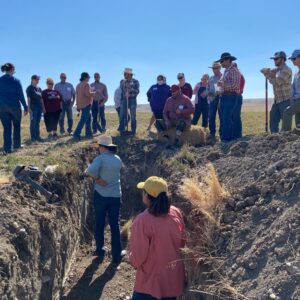
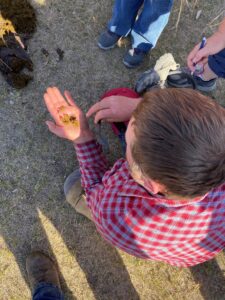
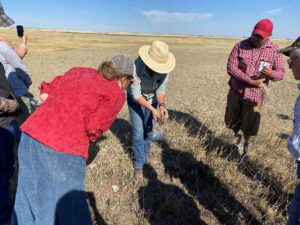
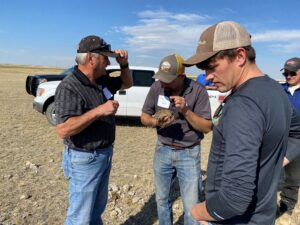
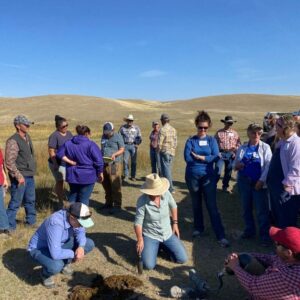
Acquisition of new knowledge and skills
Participants in each workshop took a pre and post-test on the day of the workshop. When asked about their knowledge of soil health before the workshop, the average score was 3.2 on a five-point scale. After the workshop, this number increased to 3.9. There were some attendees that went down in their knowledge of soil health but remarked that this was because they realized by the end of the workshop that they knew less than they thought they did in the first place. When asked what they planned to implement following the workshops, attendees listed: intensive grazing, brix testing forages, using natural methods of fertilizer and weed control, soil testing, and planting more diverse stands.
Changes in professionals’ attitudes or understanding
The workshop resulted in a greater understanding of soil health and how the principles can be used on ranches. Attendees came from a diversity of backgrounds from across the state. Participants came from Glacier, Liberty, Toole, Pondera, Teton, and Cascade counties as predicted but also from Yellowstone, Roosevelt, Jefferson, and Judith Basin counties and Utah. The attendees also came from a wide range of backgrounds. Two attendees were land managers for large acreages owned by out-of-staters, some were very small acreage landowners, some in the middle, and a few agency staff. The diversity in backgrounds for the attendees contributed to the greater understanding for each other and what everyone can do to improve soil health. Each attendee left the workshop with a positive attitude towards soil health and looking forward to how they can improve their ranches.
Changes in professionals’ behavior and action
Three months after the workshops, a follow-up evaluation was sent out to all attendees to see what behavior changes they had made and what actions they had taken. Five of the attendees responded to the survey, giving us a response rate of 13.5%. When asked what they had done or are planning on doing on their ranch because of the Soil Health for Ranchers workshop, producers responded with more soil tests, feeding humate and boron to livestock, mapping cheat grass infestations, rotational grazing, planting a cover crop, making a Johnson-Su bioreactor, and refraining from using insecticides in livestock. When asked what principles they had investigated further, responses included rotational grazing, micronutrients, fungi-bacteria ratio, what weeds say about soil, Korean natural farming, brix scoring, and natural cattle care. Realizing that a lot of the behavior changes that were talked about during the workshop may be difficult for some to implement, we also asked what was holding producers back from implementing changes. Financial reasons and time were the top two answers, with uncertainty being another answer.
Acquire new knowledge and skills in facilitating community food systems in Montana through staff participation in the Local Food Leader and Community Food Assessment modules offered by Iowa State University.
AERO successfully trained staff members in two Iowa State University programs: the Community Food Systems Assessment (CFSA) and Local Food Leader (LFL) courses. The CFSA course was offered virtually, beginning in April 2021. The course was self-paced. The LFL course was also offered virtually. Montana State University (MSU) Extension agents certified as LFL instructors offered the first Montana-based cohort LFL course for 20 students located across the state. The course was offered in the fall of 2021 with five virtual class meetings and approximately 40-hours of self-paced homework.
We achieved our goal to increase capacity for local food practitioners working on food systems programs across Montana.
Following participation in the courses, all participants reported an increase of new knowledge and skills. In reviewing results from our pre-survey and post-survey evaluations, we found the following results.
All participants increased their knowledge and understanding of the following topics:
- Business Development Tools (e.g. logic models, project scope, work plans, budgets)
- The impact food system sectors have on community
- Values-based Community Food Systems
- Values-based Community Food Systems relation to community and economic development goals
- Evaluation of programs, projects, and food systems change in communities
- How to design community food system projects that help to develop one of the food system sectors
(100% of respondents/course participants rated their extent of understanding and knowledge about these topics as “A great deal,” “Considerably,” or “Moderately.”)
In addition, following the course, all participants (100%) “Strongly Agreed” that:
- I feel confident partnering with other individuals or organizations to develop community food systems.
- I am effective at managing and facilitating conversations on food system topics with the community and dynamic groups of people
- I understand the importance of inclusion and building trust with diverse audiences and stakeholders.
Following the course, 84% “Strongly Agreed” and 16% “Moderately Agreed” that:
- I have knowledge of tools I can use to conduct a program or project evaluation.
- I have confidence that I can find the appropriate tool(s) to evaluate programs or projects
- I have identified my personal values that connect to my goals in food systems work
The LFL and CFSA courses were successful in increasing participants’ understanding of food system sectors, asset areas, confidence in partnering with stakeholders, and tools for evaluation, business development, coalition building, and developing food system sectors.
100% of respondents/course participants felt they “have confidence in my ability to improve networks and relationships with both local and regional cohorts” following participation in the LFL and/or CFSA course. Additionally, 100% of respondents/course participants answered either a 4 or 5 on a 1-5 Likert scale rating whether “This coursework helped me become aware of new tools and/or resources for various food sectors (production, transformation, distribution, consumption, and resource management).”
Having AERO staff trained as both CFSA assessors and Local Food Leaders is potent for our work building and supporting sustainable, resilient community food systems across Montana. Participants are already incorporating skills and knowledge learned through the LFL and CFSA courses into their daily work. Because of these trainings, AERO was able to lead and facilitate a nine-month community food systems assessment in Butte in 2021. The assessment was received incredibly positively by the community. The Butte assessment cohort identified multiple benefits including: a broader understanding and awareness of food-related issues in their community; new and strengthened relationships with different food system stakeholders; increased community participation in shaping their food system; and greater community capacity to create positive change. We are now in conversation with three other Montana communities--Fort Belknap, Billings, and Helena--to offer facilitated assessments in 2022-2024 to identify strengths and opportunities to enhance community food system collaboration and resiliency.
The two day workshop's goal is to teach extension agents and agricultural producers about basic soybean agronomic principles, adaptive policies for growing soybeans in climates with shorter growing seasons, diseases of the crop, and the opportunities that adding soybeans to a rotation can provide in relation to weed control and the prevention of herbicide resistance.
On August 24 and 25, 2021 the Eastern Montana and Western North Dakota Ag Agent training was held in Sidney, MT. This continuing education event was only possible through a grant secured from the Western Sustainable Agriculture Research and Education program.
Between the two days, there were 21 participants who attended the workshop which was purposefully kept to a smaller number to encourage audience and speaker interaction. Of the attendees, there were five Montana County Agents, three North Dakota County Agents, three State specialists (one from Ohio, one from Montana, and one from North Dakota), two representatives from private industry, and the rest were either dryland or irrigated farmers.
All participants were surveyed at the conclusion of the workshop. All but one respondent signified that their level of understanding of the agronomic principles behind soybean production increased. The lone respondent indicated that he/she had and excellent understanding prior to the workshop so there was no chance for an increase. All respondents either agreed or strongly agreed that they are more aware of the agronomic practices surrounding soybean production. All also agreed or strongly agreed that they feel comfortable sharing information learned during the workshop.
Gain of knowledge and information by Extension professionals in topics of agricultural sustainability.
A WSARE grant supported the transportation of five Montana agricultural agents to the National Association of County Agricultural Agents annual meeting and professional improvement conference (NACAA AMPIC).
This conference is the premier event for Extension professionals in the agriculture, horticulture, and ag & natural resource areas to present nationally orally or via poster presentation, learn about successful programming in other states, and to bring back ideas and training for our clientele and Extension colleagues.
Garden in a Bag, Ten Mistakes All New Beekeepers Make, Extension Retreats, Building Synergy, Collaboration, and Fun, Reporting – Work Smarter Not Harder (Using ARC GIS & ARC Survey 123), Crops TV, Drone Workshop, Edutainment – Making Pesticide Education Fun, Revitalizing a Community Farmers Market, Finding the Ideal Cow for Idaho, Grill Smart – Protecting Palatability, and Videography for Extension Programming (Super Seminar – 3 hours long) to name a few of the workshop presentations the participants attended.
There were 6 different sessions running concurrently and participants chose topics that they were interested in or that would be of use to our communities and clientele.
One agent participant reported, "Since I teach beekeeping classes the topic Ten Mistakes All New Beekeepers Make, was of keen interest to me. The speaker utilized slides to illustrate the most common errors a newbie beekeeper is likely to make and how to avoid falling into those traps. I plan to utilize this format in my next introduction to beekeeping workshop to minimize the problems my clients have and help them succeed in their beekeeping venture."
Another participant reported about the Garden in a Bag presentation. "
The Garden in A Bag idea was presented by a horticulture agent from Florida that worked in a poverty-stricken rural area. Her goal was to teach gardening one bag at a time, but also to provide Extension in a bag – providing access to the resources, information, and education provided by Extension. Though her climate differs a great deal from mine, I felt that I could utilize this idea to help underserved audiences learn about gardening with vegetables and fruits that are easy to grow and highly successful in my region. The bag includes seeds for 3 – 4 vegetables and one fruit, plus an Extension brochure on planting, growing, harvesting, and preserving information, and a QR code for a survey for feedback on the program."
The experiences and new knowledge the attending agents received will continue to echo through their communities, as they integrate ideas and information learned into the instruction they do locally and across the state.
Educational & Outreach Activities
Participation Summary:
Learning Outcomes
Project Outcomes
Face of SARE
Outreach to the Montana State University Extension staff as part of a spring update training conference in spring of 2022, to highlight WSARE programs, grant opportunities and projects to other extension professionals.
WSARE Administrative Council member Bryce Wrigley attended the Montana Small Farms conference in October 2021, and presented information about WSARE and program offerings during the two day conference.
